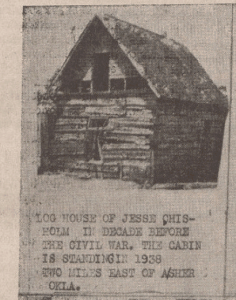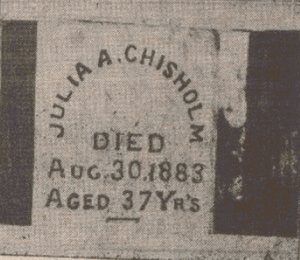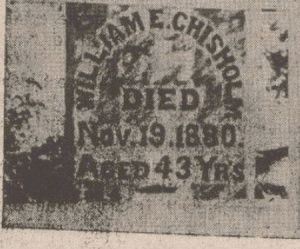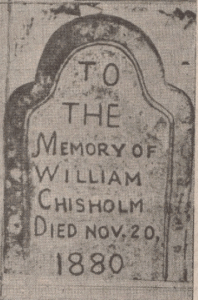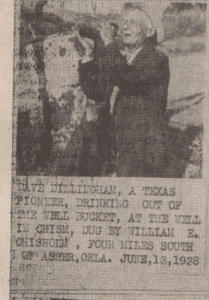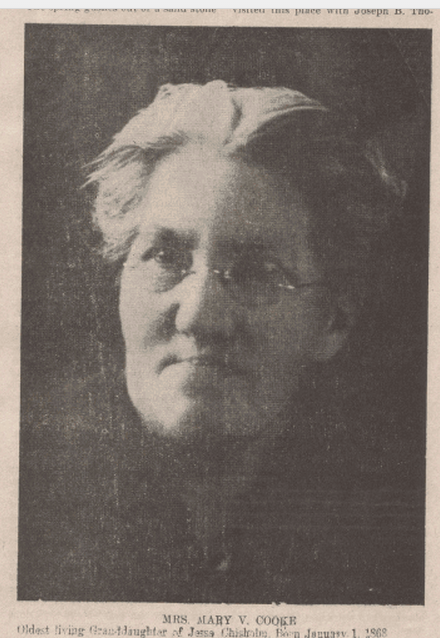By using our website, you agree to the use of cookies as described in our Cookie Policy
In the Land or the Chisholms - By T. U. Taylor, Austin, Texas
[This story is found here:]
After the dedication of the Jesse Chisholm Hall at Bandera on May 28, 1938, two old time frontiersmen, Dave Dillingham and T. U. Taylor, made plans for an expedition to the land of the Chisholms along the South Canadian in Oklahoma. Each was fired with the same ambition to go to Oklahoma and re-travel the route taken by Jesse Chisholm over one hundred years ago.
We found Mrs. Mary V. Cooke, who had passed her 70th birthday on January 1, 1938; alert, vigorous of mind but with a rheumatic right shoulder that at times caused intense pain. She treated us like we were long lost brothers and we were, in a certain sense. We were really on a quest to find Chisholm relics to place in the Hunter Museum in Bandera. We were not particular as to the relic; in fact if we could have found an old moccasin shoe that Jesse Chisholm had worn, w e would have brought it back. We found more than we expected at four of the different sites we visited. We shall take these up in order.
We shall describe these as we travel West and we shall start With Edwards' Store, five miles south of Holdenville, Oklahoma, on the south bank of Little River.
We had almost lost hope of finding the store site when we ran unexpectedly into a young man who knew the history of the whole country. We found him in sight of the bridge across the South Canadian when we were about to turn around. He got in the car with us, we turned around and were piloted a mile np the river and then across Little River into the very yard of Lewis Baker, who owns the old Edwards' store site. The south banks of the Little River is the north border of the yard of the Bakers home. The home is under some huge primeval trees that afford abundant shade and here we ran into old pioneer hospitality. Several friends were in the yard but Mr. Baker and all of them showed us the whole plant. We gazed upon dressed stones that Jesse Chisholm and his father-in-law, James Edwards, had used in walling in the cellar in the Edwards home. We walked out into a newly mowed oat field and stood on the site of the old store of James Edward where eighty nine years ago Captain Marcy stopped to get supplies as he headed his expedition on to Santa Fe.
Some years ago Mr. Baker took up the stones of the old wall, conveyed them to the north part of the yard, filled in the hole with soil and now the plow the reaper and the harrow go blithely over the soil as it were never the seat of the most westerly Anglo Saxon settlement. Here the various tribes of Indians came to trade. The store itself was about a mile west of the junction of Little River and the South Canadian and was in the jurisdiction of the Choctaws and the Chickasaws that existed from 1836 to 1856. It was almost the center of the territory of the five civilized tribes: the Cherokees, the Choctaws, the Chickasaws, the Creeks and the Seminoles, or the land of the four C's. There stretches from the Edwards store site to the south, a rich alluvial valley for many hundreds of yards and then the mountains or hills arise.
From the junction of Little River and the South Canadian, the Little River continues almost due West but the South Canadian turns toward the southwest. These rich bottoms were cultivated by Edwards and his retainers near one hundred vears ago when Sam Housten left Folt Gibson and the beautiful Talahina for Texas.
Jesse Chisholm wended his way West and landed at Edwards settlement. Here he stayed and after three years he convinced Eliza Edwards that he would make an excellent husband for her. He entered into partnership with his father-in-law and here he started those memorable treks to the West and traded not only with the civilized Indians but also the wild Indians. Jesse Chisholm was a traveling trader. Here at the Edwards store William Edwards Chisholm was born in 1837 and here another child was born that died without issue. It is believed that Jesse Chisholm remained here until the death of his wife about 1846. Jesse and Eliza Chisholm had a happy married life of only ten years.
When Edwards located the site of his store, an agriculture and stock survey could not have exhibited more wisdom. From a farmer's standpoint the land is rich as cream and the surrounding hills and territory afford a splendid farm for stock. It was easy access to Fort Gibson and here it filled another good function. All the wild tribes, including the Comanches of Texas. soon learned that white children had a high commercial value and all they had to do was to get in touch with Edward’s store. Parents in Texas, as far away as Bastrop county. went to Edwards store to get news of their lost children. Jesse Chisholm himself bought nearly a dozen of these children and adopted them and later two of them helped carve a niche in the history of Oklahoma.
George Chisholm, an adopted son of Jesse Chisholm was on the expedition in 1865 that started in Wichita, Kansas, and went 220 miles to the Southwest, to the Anadarko territory which in the next year was converted into the Chisholm cattle trail.
Texans and even Texas historians have a hard time getting it into their heads that the real Chisholm Trail never reached Texas. In fact it didn't reach within sixty miles of Texas. It is true that many trails spread out from Red River Station on the Red River to the Southwest in Texas. These Texas trails crossing the Reel River at Red River Station went northwest for a few days and then hit the Chisholm Trail.
About 1848 Jesse Chisholm located his store two miles east of Asher, Oklahoma; at the old famous Chisholm Spring, on which now lives Mr. Hersel Marshall, where, on about a couple of acres of ground, the antiquarian can walk on soil trod by Jesse Chisholm and where he can get a cooling draft from that famous old spring that slaked the throats of the Saxon and the Indian.
On Monday, June 13, 1938, the writer revisited this old spring with Dave Dillingham. Dave got down on his knees and drank from the old spring in the truly pioneer fashion. As he got up he exclained :
"Great Scott, this water must have come through an ice house. It's the coldest water I ever drank from a spring."
And the reader must remember that Dave Dillingham is no spring chicken, either. This spring is on the west side of a branch or draw and is bubbling and gurgling in the year of 1938, just as it was when Paul Revere took his famous ride. It is no mystery why Jesse Chisholm selected this spot. It was on the main highway to Edwards store and also to Choteau's store at Lexington, across the river from Purcell. Here he built his trading post, and here he lived and had his headquarters. In an air line it is some 32 miles west of Edwards' store, and about the same distance east of Lexington. It is practically the mid-way stop between Edwards' store and the Choteau store;
After Jesse Chisholm lost his wife, Eliza Edwards Chisholm, in 1846, he married Sah-kah-kee McQueen, and here he brought her as a bride, with his son. William Edwards Chisholm, who was then about ten years old. In those days the residences were crude and rude and strange to say, the home of Jesse Chisholm was also, but today it is still standing just east of the old Chisholm spring. The writer stood in this old house on June 13, 1938, and he could imagine Jesse Chisholm coming to dinner in a one room house and Sahkah-kee going over to the old spring house for the bucket of milk kept in the cool spring water inside the spring house. Glance at the crude log house, the picture of which was taken on June 13. 1938 Here Jesse Chisholm lived some ten years and from this point and on top of this point radiated caravans to the red men, both civilized and wild.
The spring gushes out of a sand stone promontory and on top of this promontory later was built the residence of the owners of the place.
When the writer visited this place with Joseph B. Thoburn and Alvin Rucker in 1930 this house was still standing and covered the spring house, but a few years ago it was destroyed by fire and the present owners have erected a neat and modern cottage nearer the road and on flatter ground. The rivulet that drains the spring runs due south into a larger stream. The highway or old road from Edwards store to Choteau crossed the rivulet some twenty feet below the spring between two large post oak trees. The abrasion of wagon wheels, the tramp of man and the erosion of rains have lowered the terrain around the trees some two feet and they now have the appearance of sitting on a small hillock. If the reader can contemplate the civilization that once stirred around this historic spring, he can recall the stirring scenes of old.
Dave Dillingham was so inspired that he unleashed the old banjo that was presented to Ben Thompson by President Diaz of the Republic of Mexico. Here he twanged out the tune of "Cotton eyed Joe" near the old post oak trees that had not heard a tune played for nearly eighty years.
No more fitting place for a State Park could be selected. There is sufficient water to keep a swimming pool fresh and clean. While standing there I could recall the scene where Indian tribes came from their homes in the west to trade with Jesse Chisholm and where they camped. He closed this place about 1860 and was engaged to pilot a tribe of Indians to the present town of Wichita, Kansas. Here Jesse Chisholm remained for the next four years and gave his name to the creek that now runs through Wichita, Kansas to the Arkansas river.
In 1863, while the Civil War was raging William Edwards Chisholm married Julia McLish, daughter of Fraser McLish. Jesse Chisholm helped his son build a log cabin and in this cabin William and Julia started their honeymoon in a primeval forest of the Chickasaw nation. This was within three miles of the Chisholm Spring, about two miles south of Asher, and about one mile south of the South Canadian. In the yard William Chisholm dug an old fashioned well; the cabin is still standing and the well is still furnishing a high grade of water. In the ancient days the water was elevated to the surface by the old fashion cedar bucket and no pioneer boy or girl needed a pioneer barrel bucket to make it stick its nose in the water and come up brimming full.
The writer tasted this water in four places in this very neighborhood in the years of 1930 and 1938 and I found the water in all cases to be pure and sweet and far superior to the water in Texas. They say that water has no taste, but just let a person get hold of some of the alkali water in West Texas, or the sulphur water in East Texas and watch his face. If it hasn't a taste, then I know nothing of what taste is.
Here the children of William E. Chisholm were born and here Mrs. Mary V. Cooke, the oldest child was born Jan. 1, 1868. Here Jesse Chisholm came to see his newborn granddaughter. He gazed on the sleeping child, fondled her in his arms and died just sixty four days later at Johnny Left-Hand spring, one hundred and five miles away as the crow flies. The news arrived by March 18, 1868, that Jesse Chisholm was dead and from this home of William Chisholm swift Chickasaw runners sped along the Canadian and south to the Red River and to the Chickasaw capital, Tishomingo, bearing the news that the uncrowned king was dead. As Mrs. Cooke expresses it:
"He saw me, but I never saw him. Our lives overlapped just sixty-four days."
Here at his home William Chisholm died at the age of forty-three years, leaving his son William, a babe in arms and his daughter, Julia, who could just toddle about the house and yard and four other children. His widow struggled to hold her family together whose ages ranged from a few months to twelve years, but this was some job in a pioneer country. and three years later, Julia Chisholm died and her frail body was buried beside her husband. The reader ran gaze on the tombstone erected for William and Julia Chisholm; also the old cabin and the old well from which they drew water. Julia Chisholm died on August 30, 1883 leaving her oldest child about fifteen years old and the youngest hardly four years old, but true to pioneer tradition, the children were not left helpless.
Douglas Johnston, later chief of the Cherokees, came swiftly to the rescue and took the youngest daughter and Stella into his home, fostered them and educated them. The youngest daughter later became Mrs . Julia Chisholm Davenport and Stella became Mrs. Stella Ward. Cora, later Mrs. J. P. McKeel, and Mary, later Mrs. Mary V. Cooke, went to Wynnewood to live. Wynnewood is now in Garvin county, about eleven miles from Paul's Valley. William Chisholm, the youngest child, went into the home of a family at White Bead, now in Garvin county, about five miles from Paul's Valley; this was about sixteen miles away from his sisters in Wynnewood. Here he lived until he was fourteen years old, and then came to live with the Cookes. Alice, later Mrs. Asbury, went to the home of Joseph Bynum at Tishomingo, a brother in law of Douglas Johnston.
On November 19, 1885, Mary Virginina Chisholm married William V. Cooke and went to live near "Chism" and here they have lived off and on for over fifty years. Early in their married life they built a two story home south of the home of her father and just west of the home is the old family cemetery.
The writer inquired for the Chisholm cemetery, but several informed me that they knew nothing about it, but I was directed to the Cooke cemetery. And today it is known as the Cooke cemetery largely because Mrs. Cooke is now the titular head of the Chisholm clan in Oklahoma.
The old home of William and Julia Chisholm was lost to the Chisholms for a while but recently a relative of Mrs. Cooke's has regained the home, the well and the graveyard. The new highway from Stratford to Shawnee passes within one hundred yards of this ancestral home.
After William E. Chisholm had located in the bend of the south Canadian in the Chickasaw nation, he soon became one of the leading factors in the affairs of the Chickasaw Nation. A small village or town starting up three miles south of the river and the citizens decided to ask for a post office and name it "Chisholm" in honor of William E. Chisholm, but the Department at Washington decided the name was teo hard to spell. They created the post office but named it "Chism" .
The town had already been located in a rather unique way by William Chisholm. He dug a town well and when the streets were laid out they decided to leave it on the south side of the street that ran east and west. The main street runs due north and south but the stem of the T runs due east and west. The well is located on the west side of the north-south road, and the south side of the west-east road.
In June, 1938, two pioneers from Texas visited the little town of Chism and Dave Dillingham quaffed his Texas thirst from the old Chisholm well, still functioning and still a going concern.
On the trip of the pioneers to Oklahoma in June, 1938, we traveled a total distance of eleven hundred miles, visiting the old stomping ground of Jesse Chisholm and the native heath of his children. Along the eleven hundred miles we had many opportunities to run into ruts, banks, trees, stumps, rocks, and bridges, but Dave Dillingham, an old Texas pioneer, who was piloting us every mile of the eleven hundred, avoided all these obstructions and pitfalls. But as we drew up in front of the old Chisholm home established by William E. Chisholm during the late Civil War and within a few feet of the old cabin that Jesse Chisholm helped his son build, we had our first accident. We were just a short distance from the old well that was dug by these two pioneer citizens, Jesse Chisholm and William E. Chisholm, and which well is still functioning. In front of the two story residence erected by Mrs. Mary V. Cooke and her husband after the death of William B. Chisholm, there had been planted many were left double orphans, and the oldest still in her teens. a young girl, at years ago some locust trees that had grown to full maturity. Not so long ago the caretaker felled these trees, making the section close to the ground but some of these stumps protruded about three inches above the ground and as bad luck would have it a sink had developed on the north side of one of the stumps, into which the wheel of the car sank
This pioneer driver had piloted ox teams, mule teams, and horse teams from Williamson county, west to Coleman, Texas, and from Fredericksburg to points west, without mishap, but in the old Chisholm yard on ground which Jesse Chisholm had trod and on which Bill Chisholm had tramped, Dave Dillingham found out that an old locust stump will play havoc with a crankcase.
We finally jacked up the car, put some weeds under the wheel and raised the axle above the stump. As we swung clear of the stump and got off Dave Dillingham remarked:
"Well, I can miss any kind of a stump in the world but a Chisholm stump and if I had to hit any kind of a stump, I am glad it was a Chisholm stump.”
In future years he can point out to Texans the dent made in his crankcase by a Chisholm stump.
As a young girl Mary V. Chisholm saw the bodies of her father and mother lowered into the soil of the Chickasaw Nation. Here at the home built by William E. Chisholm with the help of his father, Jesse, the Chisholm children the age of 17, married Will V. Cooke. She still lives in the old Chisholm neighborhood. She has passed her three score and ten years by nearly six mouths and next January 1, 1939 will celebrate her 72nd birthday and her 71 years of age. She is a mother in the Chisholm Israel, and is known far around for her good deeds and she, like her grandfather, Jesse, shows that there are in these days, Good Samaritans.
In the early eighties a sandstone monument was erected "To The Memory of William Chisholm", but the engraver made an error and carved into the stone surface that William Chisholm died "November 20, 1880".
Some years later after his wife Julia Ann (Mclish) Chisholm died it was decided to erect one monument and include both names on one shaft. On the north face of the new marble shaft is engraved the name of "Julia A. Chisholm" and on the south "William E. Chisholm".
The old sandstone monument was found lying on its face and the two pioneers from Texas on June 13, 1938, gently raised it to a vertical position and then carefully scraped a way the dirt, moss, sand, mildew, and finally were rewarded with the restoration of the letters in full. The crumbling of the sandstone, had made some of the letters indistinct, but with the aid of sharp wooden chisels all the letters became distinct enough to be retraced with a black soft pencil, and the result can be seen in full page illustration.
*************
20,000+ pages of Texas history on a searchable flash drive. Get yours today here.
‹ Back



